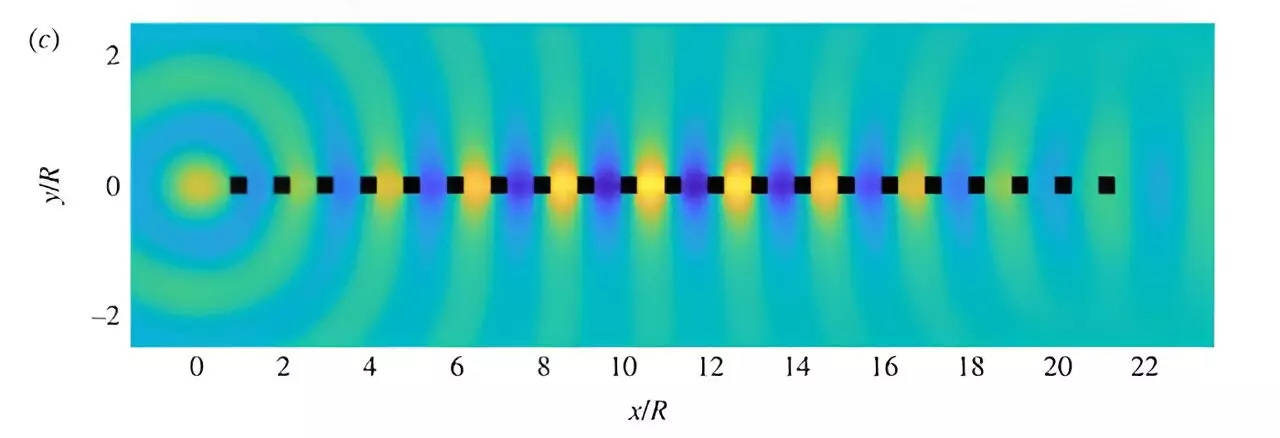In the realm of materials science, metamaterials represent a groundbreaking development, offering properties that conventional materials cannot provide. These artificially engineered materials can manipulate waves—whether sound, light, or water—thanks to their unique configurations at the nanoscale level. Recent advancements in this field have been propelled by innovative software that enhances our understanding of how these waves interact with diverse particle shapes and arrangements. A notable contribution to this field is TMATSOLVER, a cutting-edge software developed by researchers at Macquarie University, which promises to transform wave scattering analysis and metamaterial design.
TMATSOLVER operates on a sophisticated principle known as the transition matrix (T-matrix), an established concept in physics since the 1960s. This computational tool effectively models how different objects scatter waves, significantly expanding the applications of metamaterials. According to Dr. Stuart Hawkins, the lead author of the research, TMATSOLVER represents a substantial advancement in computing the T-matrix, particularly for larger particles and complex shapes—features that have historically posed challenges within the scientific community.
The software’s ability to handle complex configurations with up to hundreds of scatterers is a game changer. It allows researchers not only to simulate various particle arrangements but also to generate swift results that can feed into the iterative process of metamaterial design. This ease of use streamlines the testing of theories in metamaterials, which is crucial in a field where precision and efficiency are paramount to innovation.
The successful development of TMATSOLVER is the byproduct of a collaborative effort among mathematicians from prestigious institutions, including the University of Adelaide, University of Manchester, Imperial College London, University of Augsburg, and University of Bonn. This international collaboration exemplifies how interdisciplinary teamwork can catalyze significant advancements in complex scientific problems. Dr. Luke Bennetts from the University of Adelaide highlighted how incorporating TMATSOLVER into his research helped alleviate the computational bottlenecks that often hinder metamaterial experimentation.
Such collaborations not only enrich the research process but facilitate the exchange of ideas and methodologies across different fields, nurturing an environment of continuous innovation.
Metamaterials have promising applications across various technological sectors. Their unique capabilities enable the design of devices such as superlenses—which can visualize objects at the molecular level—stealth technologies like invisibility cloaks that manipulate visible light, and systems for perfect wave absorption that could revolutionize energy harvesting and noise control. These applications reveal the vast potential of metamaterials in creating solutions that meet emerging technological demands.
As the research confirms TMATSOLVER’s efficacy in dealing with complex metamaterial configurations, it sets the stage for rapid prototyping and validation of new designs that can harness waves in unprecedented ways. This capability is critical as industries increasingly seek materials that offer enhanced performance or novel functionalities.
The implications of TMATSOLVER extend beyond academic curiosity. With its advent, there is potential for significant advancements in both the scientific understanding and practical applications of metamaterial technologies. Professor Lucy Marshall, the Executive Dean at Macquarie University, remarked on the transformational impact of this research on materials science and engineering. The ability to simulate and design complex metamaterials could usher in a new era of inventive applications that harness waves for energy, communication, and beyond.
This innovative tool is not merely an incremental improvement; it signifies a considerable leap forward, allowing researchers to push the boundaries of existing technologies. As TMATSOLVER gains traction within the scientific community, it can catalyze the development of next-generation metamaterials poised to redefine various fields—from telecommunications to medical imaging and environmental monitoring.
TMATSOLVER stands as a testament to the power of innovation in computational methods and their influence on metamaterials research. As the software facilitates a deeper understanding of wave interactions with complex configurations, the future of metamaterials appears bright. This leap in capability not only accelerates research and development but also heralds the arrival of groundbreaking applications and technologies that could shape our world in profound ways. With the collaborative efforts of scientists from around the globe, TMATSOLVER represents a pivotal moment in the evolution of materials science—one that promises to unlock limitless possibilities.


Leave a Reply